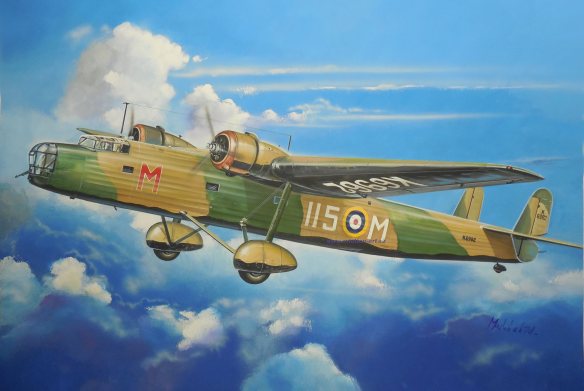
Harrow CK.Mk.8. Unit: RAF Serial: YS-DA. This is one of the first RAF aerial tankers.
Specification B. 3/34 ushered in the era of the monoplane bomber for the Royal Air Force by asking, as it did, for modern twin-engine designs to replace the Handley Page Heyford and the lumbering Vickers Virginia.
Two companies were awarded contracts to the specification, one being Armstrong Whitworth who submitted the Whitley and the other Handley Page, who’s H. P. 54 was somewhat less original in concept, maturing a high wing and fixed landing gear. It should be acknowledged, however, that although the two designs were to the same basic specification the Handley Page H. P. 54, later to be named Harrow, was intended initially as an interim bomber trainer and later, when the more advanced bombers were in quantity production, as a transport aircraft. A hundred Harrows were ordered to a new specification, B. 29/35, before the prototype flew on 10 October 1936. This new aircraft was based largely on the H. P. 51 troop carrier, which had flown in May of the previous year.
Handley Page had initiated a new method of production for the Harrow, which enabled small parts to be manufactured by small firms under sub-contract, offering advantages both in construction and repair. The first 39 Harrows built were Mk Is with 850-hp (634-kW) Bristol Pegasus X engines, which conferred a top speed of 190 mph (306 km/h), but the following 61 aircraft were Mk IIs with Pegasus XX engines of 925 hp (690 kW) giving an extra 10 mph (16 km/h). Power-operated gun turrets in the nose, tail and mid-upper positions were an advance over current service types; although the Mk Is did not have them when delivered, they were fitted later.
No. 214 Squadron at Feltwell was the first unit to receive Harrows, in January 1937, when the type began to replace Virginias, and by the end of that year four other squadrons had re-equipped with the new bomber: Nos. 37 (Feltwell), 75 (Driffield), 115 (Marham) and 215 (Driffield). No. 115 had been disbanded in 1919, and was re-formed in June 1937 to receive the Harrow, while No. 37 was also re-formed in April of that year from a nucleus of No. 214 Squadron.
Harrow production terminated with the 100th example in December 1937, but aircraft remained in service until the late stages of World War II.
A novel use of the Harrow was as an aerial minelayer when, in October 1940, No. 420 Flight was formed at Middle Wallop to carry out experiments under the code name ‘Pandora’. These aircraft carried ‘Long Aerial Mines’ (LAMs), which consisted of many small explosives charges suspended from parachutes with a 2,000-ft (610-m) length of piano wire trailing below. They were to be launched in the path of a bomber stream, and if one of these aircraft flew into the wires it was expected to release one or more of the charges, which then slid down the wires to explode on contacting the enemy bomber. Three months of trial proved the idea to be impractical, although four or five ‘kills’ were achieved, and No. 420 Flight re-formed as No. 93 Squadron, equipping with Vickers Wellingtons and Douglas Havocs.
No. 271 Squadron formed at Doncaster on 1 Maj 1940 to operate in the transport role, equipped with Harrows, Bristol Bombays and some impressed civil aircraft, and although most of the other types had been replaced by 1944 a flight of Harrows was retained. The squadron’s headquarters moved to Down Ampney Gloucestershire, in February 1944, when its Douglas Dakotas and Harrows supported the Allied forces in north-west Europe; two of the Harrows evacuated wounded from the Arnhem operation in September 1944.
Seven of the flight’s Harrows were lost in the 1945 New Year’s Day attack by the Luftwaffe on 2nd Tactical Air Force bases on the Continent, and the flight re-equipped with Dakotas in May 1945.
“Sparrows”
271 Squadron was formed on 1 May 1940 with a mixture of Harrows, Bristol Bombays and impressed civil aircraft. While the other aircraft equipping 271 Squadron were replaced by Douglas Dakotas, it retained a flight of Harrows (sometimes nicknamed “Sparrows” due to their new nose fairings to give a more streamlined fuselage) as transports and ambulance aircraft until the end of the Second World War in Europe.
Variants
Harrow Mk. I
Powered by two 830 hp (620 kW) Bristol Pegasus X engines, 19 built.
Harrow Mk. II
Powered by two 925 hp (690 kW) Pegasus XX engines, 81 built.
Specifications (Harrow II)
General characteristics
Crew: Five
Capacity: 20 fully equipped soldiers or 12 stretcher cases (used as transport)
Length: 82 ft 2 in (25.05 m)
Wingspan: 88 ft 5 in (26.96 m)
Height: 19 ft 5 in (5.92 m)
Wing area: 1,090 ft² (101.3 m²)
Empty weight: 13,600 lb (6,180 kg)
Loaded weight: 23,000 lb (10,500 kg)
Powerplant: 2 × Bristol Pegasus XX nine-cylinder radial engine, 925 hp (690 kW) each
Performance
Maximum speed: 174 kn (200 mph, 322 km/h)
Cruise speed: 142 kn [5] (163 mph, 262 km/h)
Range: 1,096 nmi (1,260 mi, 2,029 km)
Service ceiling: 22,800 ft (6,950 m)
Rate of climb: 710 ft/min (3.6 m/s)
Wing loading: 21.1 lb/ft² (103 kg/m²)
Power/mass: 0.0804 hp/lb (0.132 kW/kg)
Armament
Guns: 4 × 0.303 in (7.7 mm) Lewis Guns
Bombs: Up to 3,000 lb (1,400 kg) of bombs internally.